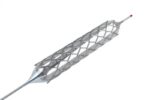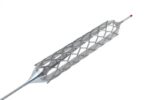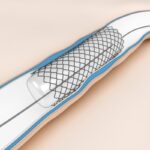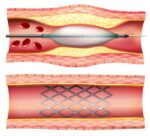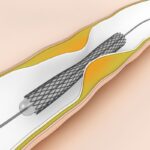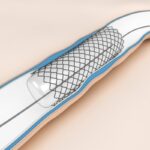Original title: Stent thrombosis in new-generation drug-eluting stents in patients with STEMI undergoing primary PCI: a report from SCAAR. Reference: Sarno G et al. J Am Coll Cardiol. 2014;Epub ahead of print. This study evaluated 34147 consecutive patients suffering acute myocardial infarction with ST-segment elevation included in the SCAAR registry (Swedish Coronary Angiography and Angioplasty Registry) undergoing primary...
1-Year Clinical Outcomes of Everolimus-Eluting Bioresorbable Vascular Scaffolds in Diabetic Patients
Original title: 1-Year Clinical Outcomes of Diabetic Patients Treated With Everolimus-Eluting Bioresorbable Vascular Scaffolds A Pooled Analysis of the ABSORB and the SPIRIT Trials. Reference: Muramatsu T et al. JACC CardiovascInterv. 2014 May;7(5):482-93. This study included ABSORB, ABSORB Extend and SPIRIT patients. A total of 136 diabetic patients and 415 non diabetic receiving everolimus-eluting bioresorbable scaffolds (Absorb) and...
The length of the stent is not an event predictor with the new generation of DES. It is the end of the Spot stenting?
Original title: Impact of the Stent Length on Long-Term Clinical Outcomes Following Newer-Generation Drug-Eluting Stent Implantation. Reference: Ik Jun Choi et al. Am J Cardiol 2014;113:457-464. Completely cover the lesion with a sufficiently long stent has been the preferred strategy that emerged from drug-eluting stents (DES). However, for the first-generation DES stent length has been a predictor of...
Everolimus-eluting stent and DEB in restenosis for BMS. Good results of both with some expected differences.
Original title: A Randomized Comparison of Drug-Eluting Balloon Versus Everolimus-Eluting Stent in Patients With Bare-Metal Stent In-Stent Restenosis: The RIBS V Clinical Trial. Reference: Fernando Alfonso et al. J Am Coll Cardiol. 2014; Epub ahead of print. Drug-eluting stents (DES) have proven to be superior in terms of restenosis than bare metal stents (BMS). BMS, however due...
Everolimus -eluting stent to 3 years, most security was the key difference.
Original title: Everolimus-eluting stents in patients undergoing percutaneous coronary Intervention: Final 3-year results of the Clinical Evaluation of the XIENCE V Everolimus Eluting Coronary Stent System in the Treatment of Subjects With de Novo Native Coronary Artery Lesions trial. Reference: Sorin J. Brener et al. Am Heart J 2013;0:1-8. The XIENCE stent (Abbott Vascular, Santa Clara, CA) is...
Drug eluting balloon followed BMS versus DES in de novo lesions
Original title: Elutax paclitaxel-eluting balloon followed by bare-metal stent compared with Xience V drug-eluting stent in the treatment of de novo coronary stenosis: A randomized trial. Reference: Francesco Liistro et al. Am Heart J 2013;166:920-6. Recently, drug eluting balloons (DEB) have emerged as a potential alternative to drug-eluting stents (DES). Paclitaxel is an appropriate drug for DEBs given...
Similar results of drug-eluting stents with biodegradable polymer versus permanent
Original title: Biodegradable Polymer Biolimus-Eluting Stent Versus Durable Polymer Everolimus-Eluting StentA Randomized, Controlled, Noninferiority Trial.NEXT trial. Reference: Masahiro Natsuaki et al. J Am CollCardiol 2013;62:181–90. Drug-eluting stents with biodegradable polymer were designed to counteract the long-term adverse effects on the vascular wall of permanent polymer. This prospective, multicenter, randomized, non-inferiority design study, compared the biolimus eluting stent with...
Everolimus Eluting Stent in multiple vessels with short SYNTAX score
Original title: A Clinical and Angiographic Study of the XIENCE V Everolimus-Eluting Coronary Stent System in the Treatment of Patients With Multivessel Coronary Artery Disease. The EXECUTIVE (EXecutive RCT: Evaluating XIENCE V in a Multi Vessel Disease) Trial. Reference: Flavio Ribichini et al. J Am Coll Cardiol Intv 2013. Article in press. Drug-eluting stents (DES ) have emerged...
2nd generation drug-eluting stents intended for left main coronary artery
Original title: Zotarolimus- versus Everolimus-Eluting Stents for Unprotected Left Main Coronary Artery Disease. ISAR-LEFT MAIN 2 Study. Reference: Julinda Mehilli et al. J Am Coll Cardiol, article in press. Improvements in 2nd generation drug-eluting stents led to increased efficiency and safety , however there is little information on these new platforms to treat left main coronary artery ....
Pharmacological stent intimal coverage with overlap versus no overlap
Original title: Tissue coverage and neointimal hyperplasia in overlap versus nonoverlap segments of drug-eluting stents 9 to 13 months after implantation: In vivo assessment with optical coherence tomography. Reference: Juan Luis Gutiérrez-Chico et al. Am Heart J 2013;166:83-94.e3. The drug-eluting stent’s (DES) overlapping effect over neointimal healing is not completely understood. Drug overdose, large amounts of polymer and...
